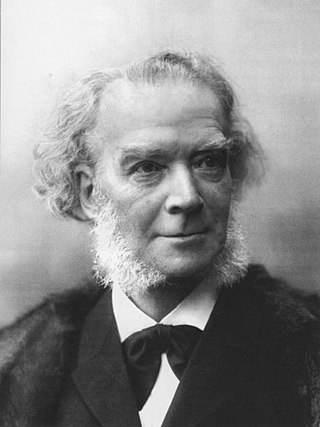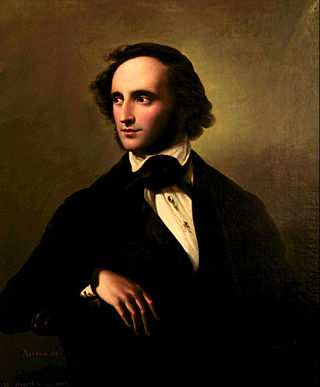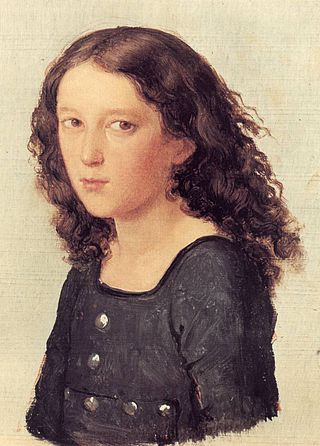
Ludwig van Beethoven's Opus 1 is a set of three piano trios, first performed in 1795 in the house of Prince Lichnowsky, to whom they are dedicated. The trios were published in 1795.

The Piano Quintet in E-flat major, Op. 44, by Robert Schumann was composed in 1842 and received its first public performance the following year. Noted for its "extroverted, exuberant" character, Schumann's piano quintet is considered one of his finest compositions and a major work of nineteenth-century chamber music. Composed for piano and string quartet, the work revolutionized the instrumentation and musical character of the piano quintet and established it as a quintessentially Romantic genre.

Carl Heinrich Carsten Reinecke was a German composer, conductor, and pianist in the mid-Romantic era.

Mendelssohn's Piano Concerto No. 1 in G minor, Op. 25, was written in 1830–31, around the same time as his fourth symphony ("Italian"), and premiered in Munich on 17 October 1831. This concerto was composed in Rome during a travel in Italy after the composer met the pianist Delphine von Schauroth in Munich. The concerto was dedicated to her. Mendelssohn attended one party after another in Munich in October 1831, the month of the premiere, but he also played chamber music and taught double counterpoint. He performed the piece himself at the premiere, which also included performances of his Symphony No. 1 and the Overture from Midsummer Night's Dream. He had already written a piano concerto in A minor with string accompaniment (1822) and two concertos with two pianos (1823–24).
Songs Without Words is a series of short lyrical piano works by the Romantic composer Felix Mendelssohn written between 1829 and 1845. His sister, Fanny Mendelssohn, and other composers also wrote pieces in the same genre.
Antonín Dvořák's String Quintet No. 2 in G major, Op. 77 (B. 49), was originally composed in early March 1875 and first performed on March 18, 1876 in Prague at the concert of the Umělecká beseda.
The String Quartet No. 14 in A♭ major, Op. 105, B. 193, was the last string quartet completed by Antonín Dvořák, even though it was published before his String Quartet No. 13. Dvořák finished his Fourteenth Quartet in 1895, when he had returned to Bohemia after his visit to America. The gestation of the Quartet had actually begun in America and lasted six months, which was rather protracted for the composer. This Quartet marked an important point in Dvořák's development because he would devote himself almost exclusively to writing explicit program music, namely symphonic poems and operas, afterwards.

The String Quartet No. 6 in F minor, Op. 80 was composed by Felix Mendelssohn in 1847. It was the last major piece he completed before he died two months later, on 4 November 1847. It is believed he composed the piece as an homage to his sister Fanny, who died on 14 May of that year.
The String Quartet No. 1 in E-flat major, Op. 12, was composed by Felix Mendelssohn in 1829, completed in London on September 14 and possibly dedicated to Betty Pistor, a neighbor and the daughter of a Berlin astronomer.
The String Quartet No. 2 in A minor, Op. 13, was composed by Felix Mendelssohn in 1827. Written when he was 18 years old, it was, despite its official number, Mendelssohn's first mature string quartet. One of Mendelssohn's most passionate works, the A minor Quartet is one of the earliest and most significant examples of cyclic form in music.

The String Quartet No. 3 in D major, Op. 44, No. 1, was composed by Felix Mendelssohn(1809-1847) in July 1838 at the age of 29. It premiered in 1839, then was published later in 1840. It is a traditional quartet, comprising two violins, a viola, and a cello. The piece is part of the Op. 44 set of 3 string quartets that Mendelssohn dedicated to the Crown Prince of Sweden.
The String Quartet No. 5 in E-flat major, Op. 44, No. 3, was composed by Felix Mendelssohn in 1837–1838 and completed on February 6, 1838. The piece is part of the Op. 44 set of 3 string quartets that Mendelssohn dedicated to the Crown Prince of Sweden.
The String Quintet No. 1 in A major, Op. 18, was composed by Felix Mendelssohn in 1826 and revised in 1832. The piece is scored for two violins, two violas and cello.
Felix Mendelssohn's Sextet in D major, Op. 110, MWV Q 16, for piano, violin, two violas, cello, and double bass was composed in April–May 1824, when Mendelssohn was only 15, the same time he was working on a comic opera Die Hochzeit des Camacho. Its composition took place between the Viola Sonata and the Piano Quartet No. 3. It also preceded the famous Octet, Op. 20 by about a year. 1824 is also the probable year of the composition of the Clarinet Sonata. Like the latter, the Sextet was not published during the composer's lifetime. Its first edition was issued in 1868 as a part of a complete collection of Mendelssohn's works. Hence the misleading high opus number.
Felix Mendelssohn's Cello Sonata No. 2 in D major, Op. 58, was composed in late 1842 — first half of 1843. The main theme of the first movement is a reworking of an unrealised Piano Sonata in G major. The Cello Sonata, which was dedicated to the Russian/Polish cellist Count Mateusz Wielhorski, has four movements:
- Allegro assai vivace
- Allegretto scherzando
- Adagio
- Molto allegro e vivace
Johannes Brahms' String Quintet No. 1 in F major, Op. 88, was composed in 1882 in the spa town of Bad Ischl, Upper Austria, and published by the firm of Fritz Simrock. It was first performed at a chamber music evening in Frankfurt on 29 December 1882.
String Quintet No. 2 in G major, Op. 111, is a work by Johannes Brahms composed in 1890 and published in 1891. It is known as the Prater Quintet. Brahms intended it to be his last piece of music, though he later produced a number of piano pieces and the two sonatas for clarinet or viola and piano. The first performance of the Quintet in Vienna on November 11, 1890 was a sensation.

The Concerto for Two Pianos and Orchestra in A♭ major was written by Felix Mendelssohn when he was 15 years old. and is dated 12 November 1824. Written for two pianos and a full orchestra, the work received its first public performance in Berlin, in 1825. The composer and his mentor Ignaz Moscheles, who inspired its composition, were the soloists. He performed it again on 20 February 1827 at Stettin, where the cathedral organist, composer, baritone singer and conductor Carl Loewe organised concerts. Loewe and Mendelssohn were the two piano soloists on that occasion.
Felix Mendelssohn wrote thirteen string symphonies between 1821 and 1823, when he was between 12 and 14 years old.. These symphonies were tributes to Classical symphonies especially by Joseph Haydn, Johann Christian Bach, Carl Philipp Emanuel Bach, and Wolfgang Amadeus Mozart.
Felix Draeseke's Quintet for Piano, Strings and Horn in B-flat major, Op. 48, was composed in 1888 and published a year later by Kistner of Leipzig. It was dedicated to Adolph Stern.






